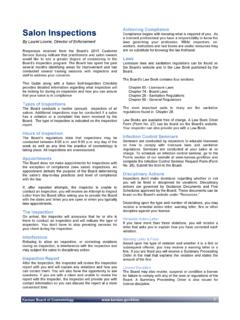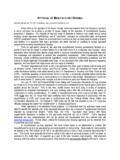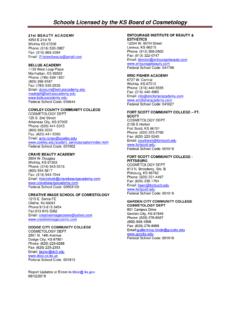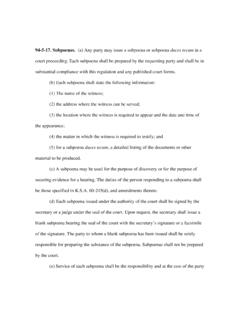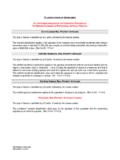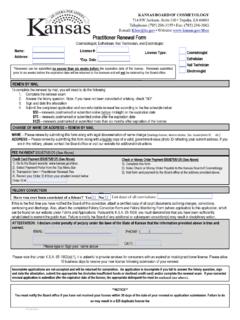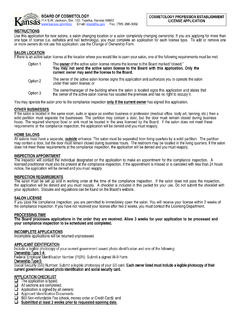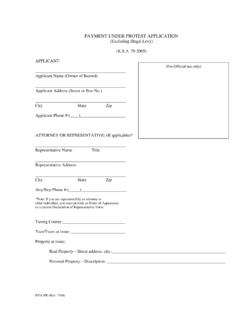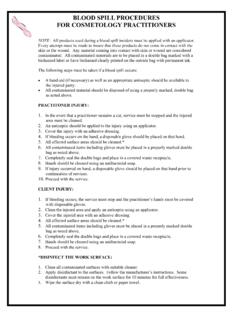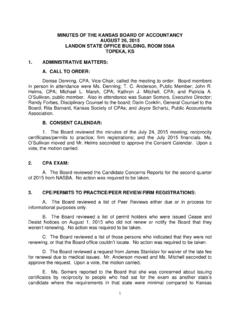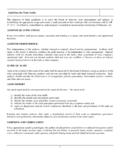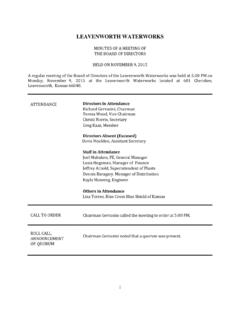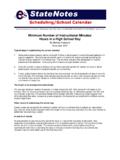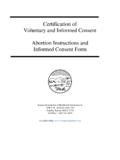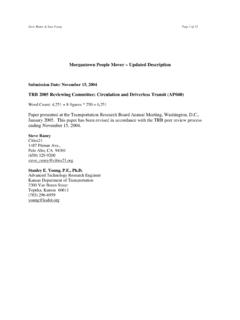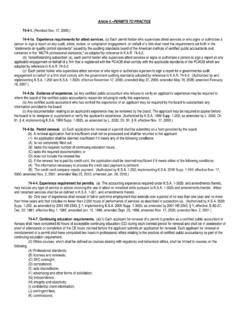Transcription of KANSAS B COSMETOLOGY HEALTH SANITATION …
1 KANSAS board OF COSMETOLOGY HEALTH & SANITATION REGULATIONS Pursuant to 65-1906(b) These Regulations must be posted in a conspicuous location in the salon. 28-24-1. Definitions. (a) Apprentice has the meaning specified in 65-1901, and amendments thereto. (b) Bleach solution means a mixture consisting of one part liquid bleach and nine parts water. The solution shall be kept in a closed container, and a fresh solution shall be made at least once every 24 hours. (c) board means the KANSAS board of COSMETOLOGY . (d) Clean means free from all soil and dirt and washed with soap or detergent.
2 (e) Communicable disease or condition means a disease or condition that is diagnosed by a licensed HEALTH care professional as being contagious or transmissible and that can be transmitted in the practice of COSMETOLOGY , nail technology, electrology, or esthetics. (f) Consumer means a person who receives services from a licensed cosmetologist, electrologist, manicurist, esthetician, or COSMETOLOGY technician. (g) EPA means the United States environmental protection agency. (h) Establishment means any place licensed by the board of COSMETOLOGY where COSMETOLOGY , nail technology, electrology, or esthetics is practiced, other than a school.
3 (i) FDA means the food and drug administration of the United States department of HEALTH and human services. (j) Licensee means any person licensed as a cosmetologist, COSMETOLOGY technician, manicurist, electrologist, esthetician, or instructor. (k) Mobile establishment means a self-contained, enclosed mobile unit licensed for the practice of one or more of the following: (1) COSMETOLOGY ; (2) nail technology; (3) esthetics; and (4) electrology. (l) Noninvasive, when used to describe procedures or services, means the procedures or services confined to the nonliving cells of the epidermis found in the stratum corneum layer of the skin.
4 The practice of COSMETOLOGY , nail technology, or esthetics shall not alter, cut, or damage any living cells. (m) Operator means the person who is licensed to operate an establishment or school. (n) Product means any liquid, cream, powder, spray, or other material used on the consumer in the practice of COSMETOLOGY , electrology, nail technology, or esthetics. (o) Protective gloves means gloves made of vinyl or latex or of an alternate material that provides equivalent protection. (p) School means any place licensed by the board of COSMETOLOGY for the training of cosmetologists, manicurists, estheticians, electrologists, and instructors-in-training.
5 (q) Single-use, when used to describe presterilized products or items, means presterilized products or items intended to be disposed of immediately after one use. (r) Universal precautions means the following guidelines and controls published by the centers for disease control (CDC), which are hereby adopted by reference: (1) Guidelines for prevention of transmission of human immunodeficiency virus and hepatitis B virus to HEALTH -care and public-safety workers: a response to 100-607, the HEALTH omnibus programs extension act of 1988, as published in morbidity and mortality weekly report (MMWR) on June 23, 1989, vol.
6 38, no. S-6; and (2) recommendations for preventing transmission of human immunodeficiency virus and hepatitis B virus to patients during exposure-prone invasive procedures, as published in morbidity and mortality weekly report (MMWR) on July 12, 1991, vol. 40, no. RR-08. 28-24-2. Personal cleanliness. (a) Each licensee or apprentice shall thoroughly wash that person s hands with liquid soap and water or with any equally effective cleansing solution before serving each consumer. (b) Each licensee or apprentice serving a consumer shall be clean at all times.
7 This requirement shall include the uniform or attire worn by the licensee or apprentice. 28-24-3. Communicable diseases or conditions; universal precautions. (a) No licensee or apprentice afflicted with a communicable disease or condition, as defined in 28-24-1, shall be permitted to work or train in a school or establishment. (b) Services shall not knowingly be performed on or by any person who has a communicable disease or condition or parasites that could be transmitted in the delivery of services under these regulations.
8 Blood-borne diseases, including HIV infection, hepatitis B (HBV), and hepatitis C (HCV), shall not be considered infectious or contagious communicable diseases or conditions under this regulation. (c) If there is a likelihood of exposure to blood or body fluids while practicing COSMETOLOGY , nail technology, esthetics, or electrology, the apprentice or licensee shall wear single-use protective gloves and shall adhere to universal precautions when exposed to blood or body fluids. (d) If a blood spill occurs, the licensee or apprentice shall perform all of the following procedures: (1) Stop service immediately; (2) don protective gloves; (3) clean the injured area with an antiseptic solution and cover the wound with a sterile bandage to prevent further blood exposure; (4) double-bag and dispose of all contaminated items; (5) clean and disinfect all equipment, tools, and implements that have come in contact with the blood; and (6) clean the station with disinfectant.
9 28-24-4. Towels, robes, and linens. (a) After a towel, robe, or linen has been used once, the licensee or apprentice shall deposit the item in a closed and labeled receptacle and shall not use the towel, robe, or linen again until the item has been properly laundered and sanitized. (b) Each licensee or apprentice shall launder used towels, robes, and linens using either regular commercial laundering or a noncommercial laundering process in which the towels, robes, and linens are immersed in water with a temperature of at least 140 degrees Fahrenheit for at least 15 minutes during the washing or rinsing operation.
10 (c) Each licensee or apprentice shall store all clean towels, robes, and linens in a clean, closed, and labeled cabinet. 28-24-5. Headrests, shampoo bowls, treatment tables, and sinks. (a) Each licensee or apprentice shall sanitize the shampoo bowls, back bars, service chairs, manicure and treatment tables, sinks, non-porous surfaces, and workstation areas before each consumer service. Each treatment table or manicure table shall be covered with a clean sheet of examination paper or a clean towel or linen for each consumer service.
